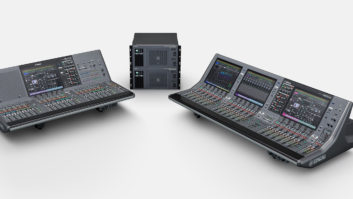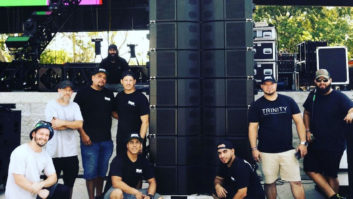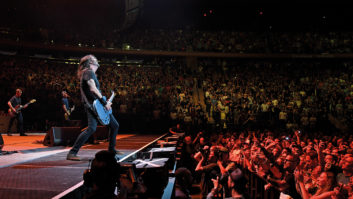Twenty-five years is a long time. The scary thing is, I’ve been involved with sound for a lot longer. It’s amazing to stop and think about how much things have changed since the beginning of the touring live sound industry. I appreciate being asked to write this short perspective on the past 25 years, but I guess the choices were limited…there aren’t really that many geriatric soundmen out there. I think I know most personally. My perspective will be a little different from some, because I’m both a mixer and an electronics designer.
In the late 1960s, when I was 18, I started my first sound and lighting company in my native Australia. We designed, built and rented psychedelic lighting, guitar amps and small column P.A.’s. I remember meeting Roy Clair when he came to Australia in 1970: Clair Brothers Audio was just a couple of years old at the time. Roy brought the P.A. system with him. It was an outdoor show at a racecourse, and I knew a way in over the back fence. I had never heard anything like it — a three-way system with folded-horn W boxes on the bass, multicell horns on the mids and ring radiators for the super highs. The show was mixed through several Altec model 1567 tube mixers, with big knobs to control the mix. And it sounded great; it made my P.A. columns look and sound anemic. I think the entire P.A. had four 15-inch woofers. Around the time Mix was hitting its stride in the early ’80s, I was mixing Bruce Springsteen’s Born in the USA tour through a P.A. with as many as 400 18-inch speakers, in places like Giants Stadium in New Jersey and the Los Angeles Coliseum. The two big walls of sound on each side of the stage would shake your chest cavity and move dresses and pants legs. The pure brute force of the P.A., coupled with straight-ahead rock ‘n’ roll, wrapped you up in the music so you couldn’t escape total involvement. Each of the 200 speaker cabinets weighed 400 pounds.
Since Mix‘s early days, I believe accountants have changed the live sound business more than anyone else. It’s expensive to cart truckloads of heavy speakers around the world, let alone unload them, put them up for the show and put them back in the truck to go to the next gig. I guess too many acts went out on the road for an extended tour, only to find that production costs ate up profits. The pencil-pushers eventually came into positions of power and demanded more efficiency from sound companies, and they responded: Over the past few years, we have witnessed an evolution from big arrays of heavy speakers to tall, slender and lightweight columns of beautifully engineered loudspeaker technology — line arrays. The old arrays of several speaker cabinets high by a bunch wide were necessary to deliver the power, but in the process, each speaker cabinet interfered with its neighbors to the left and right, above and below. Interference between speakers messed up the frequency response, reduced the overall sound level and made the sound different for each member of the audience.
Now it seems like anyone who can cut wood is building his own line array, and for good reason — a well-designed line array coaxes each speaker to work constructively with its neighbor to create an even sound for the entire audience and to deliver previously unimagined control of the coverage pattern. I used line arrays from EAW for the opening and closing ceremonies of the 2000 Summer Olympics in Australia. Earlier in 2000, I took 80 of Clair Bros.’ new I4 line array cabinets out on their first outdoor shows with Barbra Streisand. Line arrays deliver on their promise. You can more or less put the sound where you want it, and avoid shooting it up into areas that will reflect and cause nasty echoes. The audience hears very localized sound sources with great imaging.
The engineer in me strives for sonic perfection, but perfection isn’t always a good thing. I remember early in my career being driven to select microphones based on their incredible specifications, only to find that a far less than perfect choice could actually complement a screeching guitar, sibilant vocal or woolly bass. With that in mind, I have to admit that, as much as I love the pristine new line arrays, I miss the pure excitement of leaning just the right amount into the limiters of a big wall-of-sound P.A.
The electronics side of live sound has made equally big strides. Increased complexity often brings with it a decrease in reliability. Fortunately, this hasn’t been the case with modern mixing consoles, effects and amplifiers.
I remember doing shows with Elvis Presley, not long before Mix got started, where the air would be permeated with bouquet de resistor — the unmistakable smell of the resistors in an amplifier burning up. One small whiff, and you knew you were in trouble. Grounding or other weirdness could cause amplifiers to smoke in a chain reaction. I never even think about amps blowing up anymore. Manufacturers have honed their designs and manufacturing to produce amplifiers that never seem to fail.
Twenty-five years ago, mixing consoles were pretty basic — not many buses, limited routing, EQ and metering. If it was an English-manufactured board, you’d better be carrying a spare power supply, with connections for quick changeover. As mixers became more complicated, quite often the sound quality suffered. As more and more stages of electronics were added to increase routing, patching, buses, EQ, etc., the sound path increased from just a few electronic stages to many, with each one causing a subtle degradation of the sound. This was largely due to the cheap, integrated circuit amplifiers that manufacturers were forced to choose. In the past 10 years or so, integrated circuit manufacturers have improved reliability and produced amplifiers that are affordable and sound great.
Even better, we are on the cusp of all-digital sound systems. Since Mix magazine’s inception, we have seen the introduction of the CD for the consumer, and the gradual transition in pro audio from analog audio to digital. With all-digital systems, once the analog audio is accurately converted into numbers, digital mixing consoles that maintain enough internal mathematical precision can deliver mixes with zero degradation. However, many of today’s digital mixers are still affected by the quality of conversion to and from digital and by internal math compromises. Obviously, it’s a mistake to assume that just because it’s digital, it has to be better. The proof is in the listening.
Digital processing does have the potential to do a lot of things better than analog. Professionally, the digital delay line was the first digital product to really affect live sound. Portable effects processors such as reverbs, AutoTune, pitch shifters and delays are much more practical, or only possible, in the digital domain. Mixers and amplifiers have been slow to follow, because analog processing was always much cheaper to manufacture than digital. With analog processing, it’s very difficult to change a design once all the components are chosen. Once we jump into the digital world, all the limitations of analog processing go away.
I have spent the past few years heading up a team of engineers to produce a new way of processing live sound. My digital audio project, which is currently out on the road with Clair Bros., is what I like to call a mastering processor for live audio. It does all the basic things that products like XTA and BSS do, and then a lot more. And it was only made possible because of digital signal processing. For example, once we were freed of the boundaries of analog processing, we were able to create entirely new filter shapes to enable a sound engineer to get in and make surgical EQ adjustments on precisely what he wants to affect.
So, it has been a steady journey of progress over the past 25 years. It’s exciting to witness the ways new technology accelerates change. Line arrays and digital audio processing will change the landscape of live sound at an ever-increasing rate, just as disk-based recording has changed the studio scene rapidly and forever.
Bruce Jackson is a veteran sound mixer and equipment designer.







